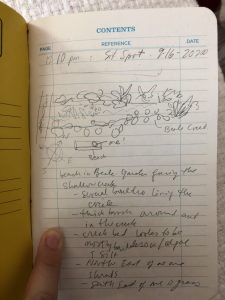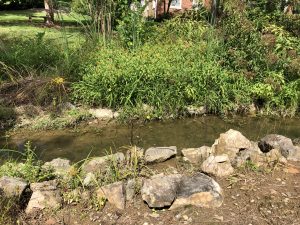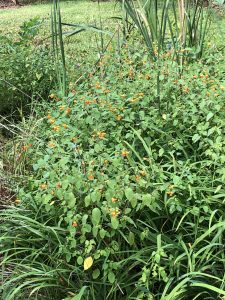September 16, 2020 at 12:10 p.m. — My sit spot is a bench in Beale garden, facing Beale Creek and the back of the Cocke building. I chose my sit spot because I wanted to observe a water ecosystem on campus. I’ve always loved living so close to Beale Creek and Beale Gard en–though so close to Front Quad, Beale Garden feels like a hidden secret garden on campus and all the time I’ve spent there, there’s never been another student–and the idea of studying this creek for the semester was exciting for me.
en–though so close to Front Quad, Beale Garden feels like a hidden secret garden on campus and all the time I’ve spent there, there’s never been another student–and the idea of studying this creek for the semester was exciting for me.
The bench that is my sit spot is at the end of a grassy field and just near the edge of Beale Creek. It’s not close enough for me to see up close into the water, so I did have to get up a few times to sit by the edge and study what was in the water. Because this sit spot is still in the heart of campus, I could hear music students practicing their trumpets at the chapel, students walking to their classes on Front Quad, and cars passing on Williamson Road. Still, the wildlife here was extremely active. I could hear many different species of chirping bugs and birds, and also studied many different types of water bugs in Beale Creek.
Our recent lab in Carvin Creek helped me with making informed observations while sitting at Beale Creek. The creek bed is a mixture of silt and boulders with a moderate amount of algae growing on the boulders. I noticed some snails attached to some of the boulders that were immersed in the creek water. This creek is a place of biodiversity on campus. There were dozens of different plant species growing in abundance along the creek, growing so thick in some areas that they nearly covered the creek up. I also noted many different bug species on these plants as well as water bugs that were on the surface of the creek.
A little further d own the creek, there was a drastic shift in the plant life. It looked as if what plants had been there had been physically stepped on and broken and what was left of them was dead and wilted. While I was there, around noon, this area was completely shaded by a nearby tree. I began to wonder if this area receives much less sunlight than the other areas where the plants grow in abundance.
own the creek, there was a drastic shift in the plant life. It looked as if what plants had been there had been physically stepped on and broken and what was left of them was dead and wilted. While I was there, around noon, this area was completely shaded by a nearby tree. I began to wonder if this area receives much less sunlight than the other areas where the plants grow in abundance.
My first focused sit-spot experience made me realize how little I know about the species inhabiting the world around me. I heard a handful of different insect species buzzing and chirping during the entire time I was there. I also heard the calls of many different types of birds in the trees around me. I want to educate myself more about these species so that I can begin naming them as I hear them outside. My sit-spot experience also made me appreciate even more how beautiful Hollins’ campus is. I live in a Front Quad building and being able to walk a few hundred feet to a beautiful creek and study the wildlife there was the best part of my day. I can’t wait for my future sit-spot experiences.
In the future, I’m going to follow a flowering shrub that grows along the creek (with beautiful orange flowers), the sounds of the crickets and other insects around me, and the depth of the creek water. On the particular day of my first sit-spot (September 16, 2020 at 12:10 p.m.), the water was fairly shallow. 

The plant is jewelweed and has a very interesting history and use by people. I enjoyed your blog Isabel and I am excited that you are interested in trying to figure out the names of the organisms that share the world with you. Once you know the name then you can learn what others have discovered as well as bring more focus to your new acquaintance. Good work!
Hi Isablel, my sit spot is behind the Cocke building too, but I sit on the chairs facing toward the creek! I love the fact that you have used the knowledge from our Carvin creek lab to identify the stream bed composition of the creek. Since we observe the same space, I am really excited to see the similarities and differences of our perspectives on things around us!